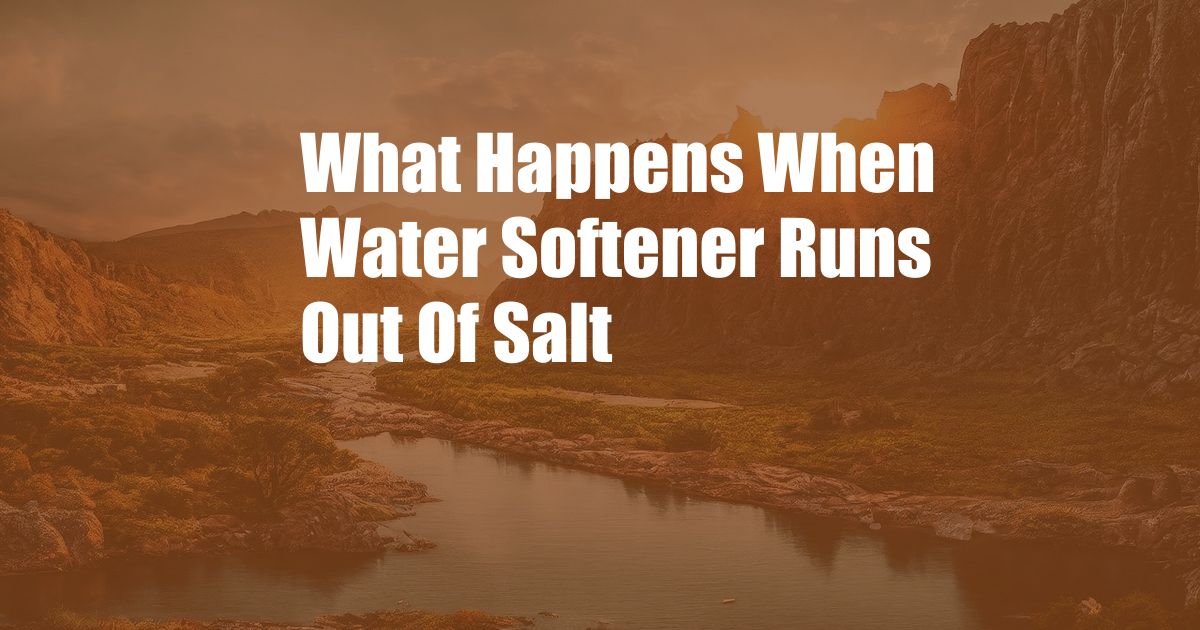
What Happens When a Water Softener Runs Out of Salt?
Imagine stepping into your luxurious bathroom, ready to indulge in a refreshing shower, only to be doused with water that leaves your skin feeling coarse and your hair tangled. That’s the reality when your water softener runs out of salt. In this article, we will explore what happens when this crucial appliance goes dry and provide expert advice to keep your water soft and flowing freely.
Water softeners combat hard water, a common problem characterized by high mineral content, primarily calcium and magnesium. These minerals interfere with soap’s ability to lather, leaving behind a residue that damages appliances and surfaces. Water softeners work by exchanging these minerals with sodium or potassium ions through a process called ion exchange. The ions are released into the water, binding to the minerals and effectively removing them.
The Consequences of Salt Depletion
When a water softener runs out of salt, its ion exchange capacity diminishes, allowing hard water minerals to pass through untreated. This leads to several undesirable consequences:
1. Reduced Water Softening: The absence of salt prevents the softener from removing minerals, resulting in harder water. This can cause scale buildup in pipes, faucets, and appliances, reducing their efficiency and lifespan.
2. Skin and Hair Problems: Hard water leaves behind soap scum that can clog pores, causing dry, irritated skin and dull, brittle hair. The minerals also interfere with the natural oils in your skin, making it feel tight and uncomfortable.
3. Detergent Waste: In hard water, soap requires more effort to lather, leading to increased detergent usage. Even then, the cleaning results may be unsatisfactory due to reduced lathering and rinsing abilities.
Expert Tips and Advice
To prevent these unpleasant outcomes, it’s crucial to be vigilant about salt replenishment in your water softener. Here are some tips from industry experts:
1. Monitor Salt Levels Regularly: Install a water hardness test strip to measure the water hardness. If it indicates high hardness levels, it’s time to add salt.
2. Choose High-Quality Salt: Use only water softener salt pellets or crystals specifically designed for water softeners. Avoid using rock salt or road salt, as they may contain impurities that can damage the appliance.
3. Add Salt Regularly: Gradually add salt to the brine tank according to the manufacturer’s instructions. Overfilling the tank can result in salt bridging and reduce its effectiveness.
Frequently Asked Questions
Q: How often should I add salt to my water softener?
A: The frequency depends on water usage and hardness levels. Generally, a household of four needs to add salt every two to four weeks.
Q: What happens if I don’t add salt to my water softener?
A: Not adding salt will deplete the ion exchange capacity, allowing hard water minerals to pass through, resulting in the consequences mentioned above.
Q: Can I use table salt in my water softener?
A: No, table salt contains additives that can damage the water softener. Use only water softener salt pellets or crystals.
Conclusion
A water softener running out of salt can have significant implications for water quality and the well-being of your appliances and skin. By monitoring salt levels, using high-quality salt, and adding salt regularly, you can ensure your water softener keeps your water soft and your worries at bay. Remember, a little attention to your water softener goes a long way in maintaining a healthy and comfortable home environment.
Are you curious about whether your water is hard or soft? Take our quick and easy water hardness test to find out. It’s the first step towards enjoying the benefits of soft water.